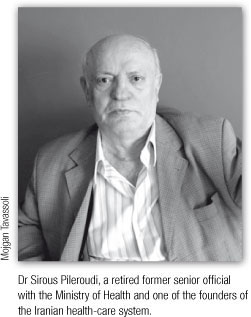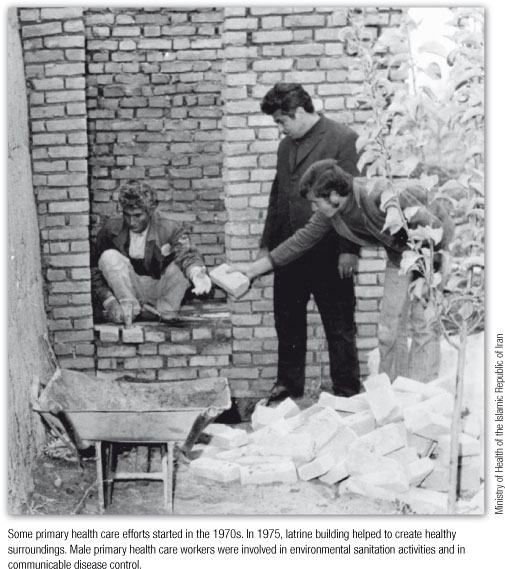NEWS
Iranian health houses open the door to primary care
Working in pairs out of modest, village-based facilities, the Islamic Republic of Iran's trained community health workers, the behvarzan, provide basic health care to most of the country's rural population. Mojgan Tavassoli reports.
They have been described as an "incredible masterpiece". The Iranian health houses, conceived and introduced during the 1980-1988 war with Iraq, have been at the centre of a so-called master plan to bring health care to every district.
Devised in 1981, the plan was informed by a health-care development programme from the Western Azerbaijan province that had focused strongly on what we now recognize to be primary health care. It emphasized community participation and intersectoral cooperation to serve the needs of the thinly distributed and rapidly swelling population.
Locally sourced health workers or behvarzan from the Farsi words beh (good) and varz (skill) were originally trained to meet the basic health-care needs of people living in rural areas. A female behvarz was responsible for, among other things, child and maternal health; a male behvarz for sanitation and environmental projects. Both worked out of the health house, a rural medical post and the most basic unit of service delivery in the country's health-care plan.
The health houses refer patients to rural health centres, which cover about 6000 to 10 000 people, and have up to two physicians and several health technicians. These centres are responsible for elective and emergency case management, supporting the health houses, and supervising both the health technicians and the behvarzan or community health workers.
Dr Sirous Pileroudi, a retired former senior official with the Ministry of Health and one of the founders of the Iranian health-care system, describes the health houses as an "incredible masterpiece". "At the beginning, we could never imagine such a breakthrough," he says. "We were at war and the country was in a miserable condition."

There was strong opposition at the time of its inception from health experts who thought the infrastructure too ambitious and the scheme a regression in health care owing to the limited education of the behvarzan. Despite this opposition and the debilitating eight-year war with its neighbouring country, Iraq, the master plan to bring health to every district has been largely successful. According to Dr Mohammad Esmael Motlaq, the director of the Centre for Healthcare Promotion affiliated with the Ministry of Health, more than 90% of the Islamic Republic of Iran's 23 million rural population enjoys health-care services through the health houses staffed by these community health workers.
"People enjoy primary health care services free of charge," Motlaq says. "The health workers are well familiar with the culture and traditions and that is a big advantage."

There are now about 17 000 health houses in the Islamic Republic of Iran, according to the most recent Ministry of Health statistics. Almost 30 000 community health workers are working in these health houses, more than 16 000 of them women. On average, each health house serves 1500 people in its village and surrounding settlements.
Community health workers are often from the village they serve, their appointment confirmed by the local rural council. Their efforts have not gone unnoticed. In a speech made in September 2007 at a ceremony to pay tribute to their work, the health minister, Dr Kamran Baqeri Lankarani, said that these community workers had made a significant contribution to the sharp decline in mortality rates in the past three decades, helping to reduce deaths among infants and pregnant women, and curbing contagious diseases.
Motlaq concurs, saying the behvarzan are the axis of the village. "A community health worker is from the people and has their approval. These workers regularly supervise people's health."
Indeed, community health workers often have an impressive knowledge of their patients' case histories. Log books on each household are kept at the health house. These contain the name, gender and age of all family members, sanitation conditions of the household, history of pregnancies, details of care for those aged under-five and dental-care records.
Among their duties, female community health workers are responsible for vaccinations, registrations and administering medicines. A male community health worker is charged with activities mainly outside the health house, such as making follow-up visits to patients and identifying them in surrounding villages. The minimum age for male and female health workers is 20 and 16 respectively. They are required to have had 11 years of regular education, plus two years of theoretical and practical training before being awarded a certificate to be allowed to practice. "Even after their graduation, the behvarzan are subject to regular monitoring and distance-learning," Motlaq says.
Dr Kamel Shadpour, another of the Iranian health-care pioneers, says the practice of keeping the "vital horoscope" - a circular chart resembling a horoscope and displaying extensive details of births, deaths and family-planning activities - is central to the health houses' functions and provides crucial data to higher levels of the network and the Ministry of Health about the health houses' activities.
"Health houses serve as the powerful arm of rural health-care centres. They did well when the main issue in the country was to contain contagious diseases. They are doing the same now vis-à-vis chronic diseases like diabetes and hypertension, and also in improving nutrition, the control of iodine disorders, iron-deficiency anaemia and fluoride treatment."

Motlaq says the strengths of the Iranian primary health care system are that health houses are highly efficient compared to other health-care service-providing units (such as ambulatory and hospital services), that the primary health care system provides an effective education system for community health workers, it standardizes services and is effective also because of the community health workers' close links with the villages in which they work.
Despite the progress made in primary health care over the past three decades, Motlaq says rapid societal changes present further challenges - epidemiologic, demographic and socioeconomic - requiring the Islamic Republic of Iran to introduce several changes. These include improving cooperation between scientific and executive bodies and decentralizing decision-making to address local needs. He says that the Islamic Republic of Iran needs to improve health information systems to acquire critical data for such decentralized decision-making. He also says that the health-care system should be more flexible and sensitive to environmental changes, that communities should play a more active role in primary health care and that chronic diseases should be better integrated into primary health care.
Maryam Alaini, 25, has been working in the health house in the village of Afjeh in the suburbs of the capital, Tehran, for two years. "I'm a high-school graduate. I'm the sole female community health worker and I am working with a male health worker," she says. "Besides my natal village Afjeh, we cover satellite villages, namely Sink, Henzak and Anbaj. We are responsible for 50% of the health-care services in the village and the rest is up to a physician who visits the village every Saturday. Fifteen people visit the health house each day and the figure more than doubles when the physician is available." She says the clients come to the health house for general consultations, to have their blood pressure checked, to be treated for diabetes, or for minor ailments such as the common cold.
Alaini's health house covers 1215 Iranian and 67 Afghan-born villagers. She knows many of them and is fond of her job. "We visit our schools once a week and tell the schoolchildren how to keep their hair, nails, mouths and teeth clean. If we observe any problem, we will refer the case to the relevant doctor," Alaini says. 
